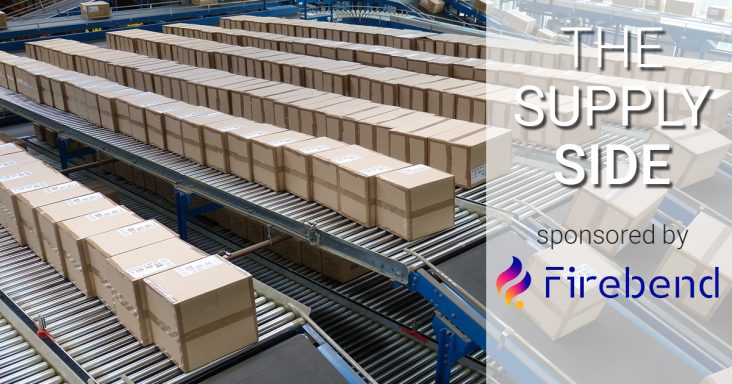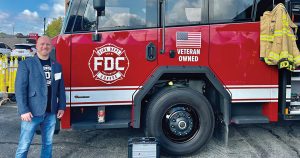The Supply Side: Fire Dept. Coffee celebrates 1 successful year in Walmart
by October 17, 2024 9:09 am 1,700 views

Rockford, Ill.-based Fire Dept. Coffee just celebrated its inaugural year as a Walmart vendor. Luke Schneider, CEO and founder of the company, said it’s been a wild ride to follow his passion for creating coffee brews and helping support the fire department community.
“I was a firefighter and paramedic who liked coffee and became passionate about the crafting process of roasting coffee. My wife, Kate, was a barista at the time, and we were going around and trying all the different coffee blends and decided to start brewing ourselves and start selling at farmers markets. We leased an 800-square-foot space in a strip center and purchased a 5-kilo coffee roaster. We started roasting there and doing tasting events for friends and family. I had a fire department blend that supported a burn camp for kids,” Schneider said.
Fire Dept. Coffee original is their favorite blend among all they have developed. He founded Fire Dept. Coffee in 2016. Schneider said because there is a big need to support sick and injured firefighters, that would be the company’s mission. The mission-minded coffee startup began selling online and got into national retail in 2021 with Meijer and then Albertsons.
But, the company’s top goal was to get the coffee brand into Walmart stores because then it would be available nearly everywhere. Schneider, also a Navy veteran, stepped away from firefighting to become CEO of the growing coffee brand in early 2020.
GETTING INTO WALMART
Schneider said he started the company bootstrapping it with the help of friends and family, but when the company needed to boost brewing capacity, it sought out lenders. When Fire Dept. Coffee met up with Walmart at a veterans event in the Midwest in early 2023, the brand was already being sold in about 2,000 retail stores. Even so, Schneider said Walmart was still the No. 1 targeted customer.

“We met Mark Espinoza, a senior exec from Walmart, at a veterans event, and we stayed in touch. He sent us an invitation to come to Open Call in October last year. We were thrilled to come and pitch, but when we got to Bentonville, the coffee buyer was ill, and we had to pitch to the senior vice president and vice president, making us a little nervous. But everything went great,” he said.
Melody Richards, head of grocery pantry at Walmart, met with Fire Dept. Coffee and said she had been thinking it would be in around 200 stores, but when she heard about the company’s capacity, she went all out with 2,400 stores.
“We could not have been happier,” Schneider said. “We added about five new people to our team because of the Walmart business. We have around 50 employees, and we are in around 11,000 retail stores. Walmart expanded us nationwide to around 3,000 stores in June. Our growth strategy is three-pronged. We sell to mass retail, grocery retail and online. We think if we continue to grow our Walmart business, everything else will fall into place,” he said in an interview.
Schneider said once the brand got into Walmart, lots of other retailers called them, and online sales took off.
Schneider said before pitching to Walmart, the company raised about $2 million and another $1.6 million through a crowd-sourcing engine. They also received private funding from the Joseph Slawek family trust. He said Slawek, who sold his Fono food business to McCormick in 2020 for $710 million in cash, is a mentor to him.
“We are growing profitably at this time, and our plans are to continue that journey now that we have invested so heavily in infrastructure and capacity. We are now using about 20% of our roasting capacity. We also have a shipping and receiving warehouse and a retail storefront to sell merchandise,” he said.
Schneider said half of the company’s sales are online. Over the past year, Walmart said it sold 2 million cups of Fire Dept. Coffee products, and it has not yet been a complete year. The retail product is sold in bags and K-Cup sizes.
STAYING RELEVANT
In 2022, Schneider said the company began to experiment with using whisky and wine barrels to age the coffee with the goal of making the brew unique. He said initially he found the taste and off-notes were ashy and inconsistent. That prompted Schneider to infuse the spirit directly into the green coffee beans. That worked better, and he developed a proprietary process to use liquor and natural flavors to create a new flavor profile for the coffee. He said the alcohol content burns off in the brewing process, making the coffee non-alcoholic, yet spirit infused.
The process of spirit infusion allows Fire Dept. Coffee to experiment with new flavor pairings that don’t exist in other brands. He said all the flavor additives are natural. One popular infusion is the Black Cherry Bourbon coffee, but the original Fire Dept. Coffee and the Black Onyx Expresso are the two biggest sellers. He said the Black Cherry Bourbon was the first successful blend. Other blends include bourbon and vanilla bean, tequila and rum, and Irish whiskey-infused coffee.
Schneider said the spirit-infused coffee blends are different from other coffees, and that’s a differentiator for the company in a crowded coffee market. He said brands have to stay unique and relevant, and the company uses social media to promote the coffee brand.
Jason Patton, senior vice president at Fire Dept. Coffee and a firefighter, founded the blog “Fire Department Chronicles,” noting that high-quality coffee and laughter were top two essentials on the job. Patton began to make humorous videos about firefighters and their way of life, always touting the importance of high-quality coffee. The videos were shared regularly on social media and found a life of their own.
In 2024, Fire Dept. Coffee and its chronicles reached 1 million followers on YouTube and received the coveted golden play button. Schneider said the videos brought thousands to the brand before they ever saw the coffee in a retail store. Patton said he started making the videos as an outlet for the stress he endured from his job as a firefighter and first responder.
“Then I started getting messages from other firefighters and first responders saying that it helped them to laugh after bad calls,” Patton said. “So, we keep doing them.”
Schneider said the company gives between $15,000 and $20,000 monthly to help injured and ill firefighters. By the end of 2025, the goal is to have given $2 million to efforts that support firefighters and first responders.
Editor’s note: The Supply Side section of Talk Business & Politics focuses on the companies, organizations, issues and individuals engaged in providing products and services to retailers. The Supply Side is managed by Talk Business & Politics and sponsored by Firebend.
